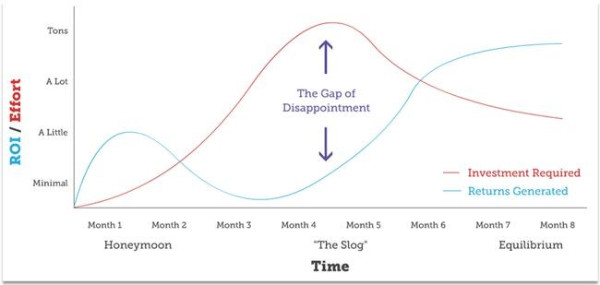Have you ever wanted to teach a pack of thirty 12 year old kids?
No?
That’s OK. Not many people find the prospect appealing.
But I did it for three years, and while it wasn’t easy, it was very rewarding.
I loved my experience as a teacher, and I was disappointed that I couldn’t continue to teach when I moved to Vancouver (without doing another 4 year degree, of course).
But as they say: When one door shuts, another one opens! And with my move to Vancouver came a career change and I found myself launched into the wonderful world of marketing.
As with any job, your old experiences influence how you approach a new position.
This can sometimes be a negative thing, but at other times, a positive. I wasn’t sure what connections there was between teaching and marketing or what influence my teaching experience would have on my current role as a marketer, but as time goes by and I get more comfortable in my new career, there have been certain areas where I can see my old teacher-self shine through.
A Good Sense of Humor is the Key to Success
When I first started teaching, I was given 2 pieces of advice.
- You have to have a good sense of humor.
- Don’t smile until Christmas.
I know what you’re thinking: How are you supposed to have a sense of humor and not smile for months?
It’s actually quite simple.
You completely ignore one of the pieces of advice.
No prizes for guessing which one I ignored!
Of course, I smiled before Christmas. Maybe not a lot in the first year (teacher training is hard!) but I definitely did in the following years.
Why?
Humor in the classroom actually helps with learning, as a 2004 study “Teaching Styles and the Use of Humor” found, humor can:
- Facilitate retention of novel information;
- Increase learning speed;
- Improve problem solving;
- Relieve stress;
- Reduce test anxiety;
- Increase perceptions of teacher credibility.
That is far too many benefits for me not to include humor in the classroom. Moreover, being funny is part of what makes me, well… me!! And I wanted the students to know that they had an authentic human being standing in front of them.
But what does humor in teaching and marketing have in common, you ask?
How I Use Humor in Marketing
If humor in the classroom has this many benefits on learning, then why shouldn’t the same logic be applied to humor in marketing?
I write informative blogs that are aimed to help small businesses and start-ups improve their inbound marketing strategies. I could easily rephrase this and say that I’m teaching people how to best marketing their business and they’re learning from me.
Being humorous in my job as a digital content marketer is easy.
As easy as putting the above picture in this blog post, actually.
But funny photos in blogs aren’t enough: You need to carry your sense of humor around you like a badgy of honor.
All you have to do is add a sprinkling of laughter into an otherwise professional blog post; Share a few jokes and funny observations with people that you’re networking with; Share funny (but appropriate) images on social to brighten up people’s days.
This makes Spokal as a business much more approachable. It means that my audience is willing to reach out and connect and ask questions. It means that I help people and put a smile on their face.
Correct me if I’m wrong, but I don’t see any downsides here!
P.M.A. – Positive Mental Attitude
Teaching and marketing don’t always see eye to eye, but when it comes to perspective: They both demand a lot of positivity in order to be effective (and so you don’t lose your mind).
During my formative teaching years, I soon found out that I did not want to be a disciplinarian style of teacher. It didn’t suit me. It made me (and my students) absolutely miserable.
Of course, I had to set the standard ground rules. These were a set of rules that the students simply weren’t allowed to break. They were very general and they were very basic.
And then I introduced the “tick” chart.
I had a chart with everyone’s names printed out in each subject. Every time a student did something that was exemplary, they got a tick.
This could be anywhere from making a valid point, writing a great essay, answering the extra question, getting 100% on an exam etc. When the students got 4 ticks they got a homework coupon that they could use to get out of doing a particular piece of homework.
It worked great. The atmosphere in that classroom was incredible. Students rarely misbehaved and they were performing at a higher rate than I’ve seen 12 year-olds perform at ever.
It became a regular occurrence that they would hand up extra work, tell me about the interesting facts they discovered while doing homework, shoot their hands up to answer a difficult question etc.
Moreover, they were happy.
Being Positive in Marketing
When I’ve focused on being positive in both teaching and marketing, I’ve noticed a huge difference in how people receive what I’m saying.
And this isn’t just in my head.
A recent study of conducted by Penn University in conjunction with the New York Times demonstrated that positive stories are shared more than negative ones.
There are 5 main areas that I like to shine a positive light on when it comes to marketing:
- Emails
- Blogs
- Webinars
- Comments
- Social
In these five areas, you can easily be encouraging, positive and rewarding with people. Thank people for writing content that you enjoyed, for attending your webinar (or hosting their own), for reading and commenting on your blog, for just being awesome customers on Twitter etc.
Focus on a person’s positives. Make them feel good about themselves.
As psychologist Barbara Fredrickson, creator of the broaden and build theory, states in her book Positivity, “Positivity also alters how you see connections with others… You think ‘we’ instead of ‘me.’” By cultivating the ‘we’ and increasing the probability of bringing people onto your side, you also increase the willingness to accept an offer”.
In fact, researchers at the University of Michigan wanted to find out exactly was the influence between positivity and negativity on the role of negotiation scenario in business.
The participants of the study had to work out the final arrangements of booking a catering service for their upcoming wedding reception. The business manager of the catering company, who was played by a professional actor, explained that the quoted price of $14,000 had to be increased to $16,995 because of market pricing fluctuations.
Three different versions were performed for each set of participants, delivering identical terms but with positive, negative, or neutral emotion.
The results?
People who heard a positively toned pitch were twice as likely to accept the deal as people who heard a negatively toned pitch.
What does that mean for marketing?
Being positive means you’ll likely have people agreeing with you more. Customers agreeing with you more are customers that are more likely to buy from you.
It’s Not About You, It’s About Them
Turning “me” into “we” isn’t just about positivity: It’s about changing your perspective.
When I first started teaching, I was solely focused on my grades and passing my course. As soon as I had, things took a drastic change. I stopped creating lesson plans that were designed around a set of rules that I had learned on pedagogy the previous week and started to focus on what my students needed.
They needed to be engaged in the work. They needed to be challenged. They needed to feel comfortable.
I stopped focusing on me. I started focusing on my students. I started focusing on what would make them happiest as we went through the curriculum, what would make it as enjoyable as possible, what would improve their experience in going to class and how I could present this information so that they would retain it easily and feel more confident that they could achieve success in their exams.
It didn’t hit me how much the students appreciated this until the first parent-teacher meeting.
Aside from a few parents gasping when they realized how young I was, all of them were happy to meet me. Some of them even quoted a few of the acronyms I had taught the students in order to better remember certain lessons.
I was a little shocked, but super happy that this was really hitting home (pun totally intended).
It didn’t strike me just how much I had been helping the students by focusing on their needs until one parent told me, while talking about her child’s poor attendance, that the only reason the student ever went to school was to go to my classes.
I know – I nearly broke down in tears too. But it just goes to show you that making it all about them is making a difference, even if you don’t realize it at the time.
It’s Not About Your Business, It’s About Your Customers
Teaching and marketing have another very important thing in common: They both work for the benefit of other people.
With marketing, we’ve come to know and love the term “the customer is always right” because we aim to give the customer what they want.
You know this, I know this this… We’ve all got this down.
And we’re slowly but surely realizing that it’s not just that they’re right: It’s that they should be the absolute central focus of everything we do.
Keeping this in mind will help with your content marketing too, because content marketing is slow to show its true ROI.
As you can see from the graph below, depicted by Scott Clark and Rand Fishkin, there is a “slog” that happens in content marketing, where numbers go down and spending goes up. This isn’t a fun time, but focusing solely on what your readers and customers are looking for, will ensure that you’ll be able to beat the terrible Gap of Disappointment.
Encouraging Curiosity & Engagement
Focusing on their needs also meant focusing on creating lessons that will engage and intrigue them.
I want the students to want to learn and to do this I wanted to inspire curiosity. Which then, of course, would inspire their will contribute to the lesson in order to discover answers and information.
This took the shape in small ways such as showing them a picture and getting the students to try and work out themselves what was going on in it, before I told them more details.
Or by making boring activities, such as when I needed them to take notes from the board, interesting by leaving out key terms and encouraging them to come up to the board and try to insert the correct term.
Using the power of curiosity, you can pull anyone into your lesson.
Getting People To Curious About Your Content
Teaching and marketing also use the power of curiosity in a similar way.
The aim of the game is to pull people in, make them want to read your post and make them want to get to know you and your business better.
Content marketing is all about writing content that demands to be commented on & shared.
Titles
Writing great tiles is so important.
Actually, they’re the singularly most important thing you do with creating content.
Titles are a great way to get people curious about your content.
Like this one, for example!
The title of this blog is: “What Does Teaching And Marketing Have In Common? A Lot, Actually”. Here I’m working off of your curiosity. I’ve asked a question, and I’ve given a vague (and perhaps unexpected) answer.
But now you want to know what it is that makes them similar, right???
And utilizing the art of curiosity doesn’t have to end there. You can equally tap into this on social media platforms when you’re sharing content too!
Staying Organized in Teaching and Marketing
There’s one thing that applies to all jobs , not just teaching and marketing, and that’s staying organized.
As a teacher, you learn very quickly how things can go south if you don’t take the time to stay organized. Lessons flop, the students get impatient, grades slip, tempers get raised, subjects don’t get taught properly leaving gaps in knowledge.
In the end, an organized work space will save you time, will keep you productive and will keep you in a more positive frame of mind (there’s nothing more frustrating than losing something you really need!).
During my years as a teacher, I learned how important planners, deadlines, folders, clear writing and preparation were to a successful and relaxed class.
Organization and Marketing
The same has to apply to marketing.
Made a new contact?
Add them to your influencer list.
Have an idea for a blog?
Add it to your blog idea template.
Want to curate more content?
Schedule it into your work day.
From the smallest to the biggest things, add them to your planner, your Evernote or whatever other tool you used to stay organized – it will make all the difference.
How did an old job effect the way you do your current job? Please feel free to share your stories!














